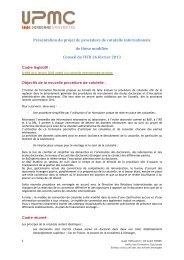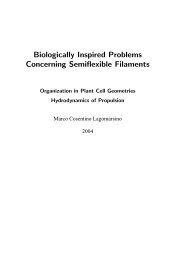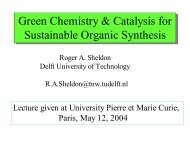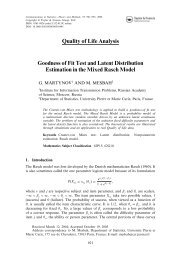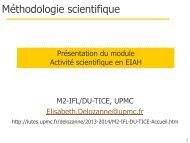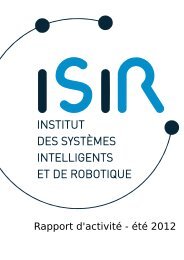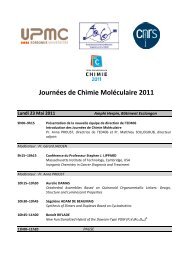résumé (Format PDF) - ED 406 - Université Pierre et Marie CURIE
résumé (Format PDF) - ED 406 - Université Pierre et Marie CURIE
résumé (Format PDF) - ED 406 - Université Pierre et Marie CURIE
You also want an ePaper? Increase the reach of your titles
YUMPU automatically turns print PDFs into web optimized ePapers that Google loves.
Journées Bibliographiques de l’<strong>ED</strong>CM<br />
Prof. Nicolas GIUSEPPONE<br />
Towards Self-constructing Materials: A Systems Chemistry Approach<br />
University of Strasbourg, Institut Charles Sadron CNRS<br />
23 rue du Loess, BP 84047, 67034 Strasbourg Cédex 2, France<br />
e-mail: giuseppone@unistra.fr<br />
The confluence of dynamic and constitutional features<br />
related to supramolecular self-assemblies [1-2] – when they<br />
occur within mixtures of comp<strong>et</strong>ing molecular architectures –<br />
has recently opened a very intriguing branch of chemical<br />
science, the so-called dynamic combinatorial chemistry<br />
(DCC). Within this framework, emerging lines of<br />
investigations have been directed towards the development of<br />
dynamic combinatorial materials and devices. [3,4] These ones<br />
can be defined as multi-component chemical systems which,<br />
thanks to the reversibility of their interconnections within n<strong>et</strong>works of comp<strong>et</strong>ing reactions,<br />
and thanks to their sensitivity to environmental param<strong>et</strong>ers, aim at performing modular<br />
functional tasks by responding to external stimuli. The behaviour of such dynamic materials is<br />
by essence more complex than the one produced by their static or single-component<br />
counterparts and as such, they hold higher potentialities in terms of information processing<br />
and functionality tuning. Besides materials science, another recent approach in DCC consists<br />
in coupling n<strong>et</strong>works of reversible reactions with autocatalytic loops, in order to combine<br />
their constitutional “plasticity” with a self-replicating process as an amplification tool. [5-7] We<br />
will discuss some of our works concerning such responsive systems along these two different<br />
lines and, more particularly, we will focus on their merging to access self-constructing<br />
materials with advanced functional properties for electronic conduction. [8-10] We will also<br />
outline the potential of such systems to act as vectors of information. [11-12]<br />
[1] Moulin, E., Giuseppone, N. – Encyclopedia of Supramolecular Chemistry – From molecules to<br />
nanomaterials - Reactions in Dynamic Assemblies, John Wiley & Sons, Ltd., 2012, 4, 1543.<br />
[2] Giuseppone, N., Lutz, J.-F., Nature, 2011, 473, 40.<br />
[3] Moulin, E., Cormos, G., Giuseppone, N., Chem. Soc. Rev., 2012, 41, 1031.<br />
[4] Tauk, L., Schröder, A., Decher, G., Giuseppone, N., Nat. Chem., 2009, 1, 649.<br />
[5] Xu, S., Giuseppone, N., J. Am. Chem. Soc. 2008, 130, 1826.<br />
[6] Nguyen, R., Allouche, L., Buhler, E., Giuseppone, N. Angew. Chem. Int. Ed. 2009, 48, 1093.<br />
[7] Moulin, E., Giuseppone, N., Top. Curr. Chem., 2012, 322, 87.<br />
[8] Moulin, E., Niess, F., Maaloum, M., Buhler, E., Nyrkova, I., Giuseppone, N., Angew. Chem. Int. Ed. 2010,<br />
49, 6974.<br />
[9] Faramarzi, V., Niess, F., Moulin, E., Maaloum, M., Dayen, J.-F., Beaufrand, S. Zan<strong>et</strong>tini, J.-B., Doudin, B.,<br />
Giuseppone, N., Nat. Chem. 2012, 4, 485.<br />
[10] Moulin, E., Cid, J.-J., Giuseppone, N., Adv. Mat. 2012, DOI: 10.1002/adma.201201949.<br />
[11] Giuseppone, N., Acc. Chem. Res., 2012, 45, 2178.<br />
[12] Du, G., Moulin, E., Jouault, N., Buhler, E., Giuseppone, N., Angew. Chem. Int. Ed. 2012, 51, 12504.



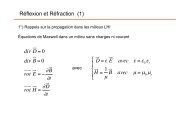
![Lingot-12-10-2012-ED.ppt [Mode de compatibilité] - L'UTES](https://img.yumpu.com/50141784/1/190x253/lingot-12-10-2012-edppt-mode-de-compatibilite-lutes.jpg?quality=85)
